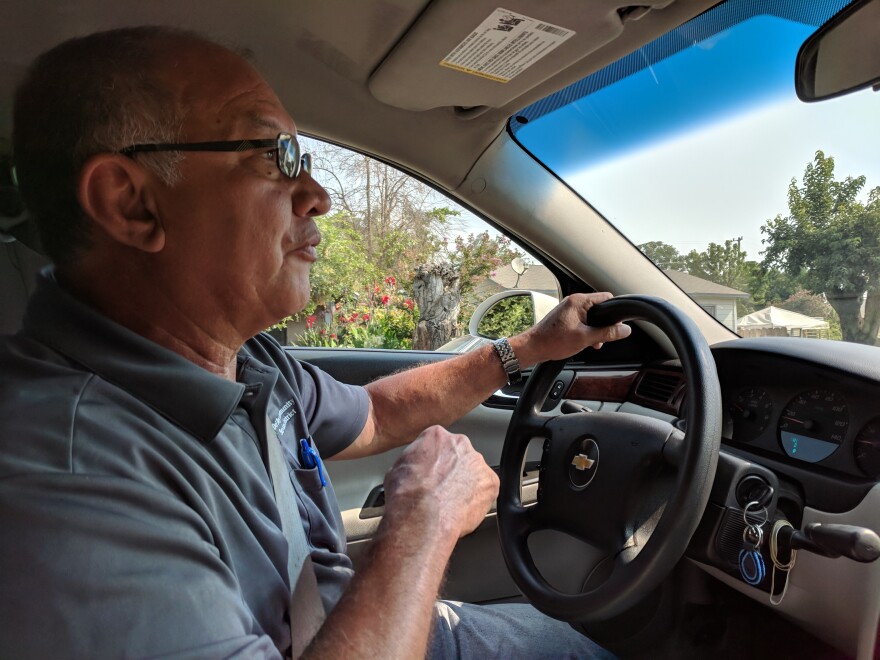In our 2017 series Contaminated, we told the stories of communities throughout the San Joaquin Valley struggling to access safe drinking water. Since then, the state has begun regulating a new drinking water contaminant. And though that regulation represents increased accountability, it brings financial challenges to some communities—and many are turning to the courts to help pay for water treatment. We begin this story in Del Rey, an unincorporated community in central Fresno County.
Maria Ayala loves to cook. The Del Rey clothing seller says prepares all manner of typical Mexican dishes for her husband and daughter.
Recently, however, cooking’s become complicated. Earlier this year, she received a letter explaining some of Del Rey’s water contains a carcinogen known as 1,2,3-TCP. “We’re now buying bottled water,” she says in Spanish, “but it’s not enough for everything.”
She also says she’s confused about what she can and can’t do with the tap water. “What I don’t know now is if I can bathe in the water,” she says. “Nothing has happened to me yet, but I don’t know what will happen in time.” (Note: Skin contact and inhalation of 1,2,3-TCP have been documented to irritate the skin, eyes and throat, but only in concentrations orders of magnitude higher than levels documented in water systems to date.)

This is why Carlos Arias wants to fix the 1,2,3-TCP problem quickly. He’s the manager of Del Rey’s community services district, and he’s pointing out one of the five drinking water wells scattered throughout the community. A pipe into the ground is hooked up to a few gauges and a 15,000-gallon tank the size of a small school bus. “Water comes out of the well, goes to the reservoir, and from there is distributed to the different places,” he says.
In order to filter 1,2,3-TCP out of all of its drinking water, Del Rey will have to install four individual filtration systems. Between construction and long-term maintenance, a contracting company estimated the entire project would cost more than $18 million. And that was in 2017. The estimate has since risen due to steel tariffs and other factors. “We can't afford to do it,” Arias says. “The district itself doesn't have enough money. The people in Del Rey can’t afford it.”
Instead, Arias hopes a lawsuit can help. And so do dozens of other Valley communities in similar situations, though many could be waiting for years.
Short for 1,2,3-trichloropropane, 1,2,3-TCP is a chemical that was used until the 1980s in pesticides, fumigants, and industrial solvents. California added it to its list of cancer-causing chemicals in 1992, but the state water board began regulating the chemical only late last year.
Now, like other contaminants, 1,2,3-TCP is regulated by a maximum level allowed in drinking water. That legal limit helps hold water districts accountable for providing safe water, but for small unincorporated communities like Del Rey, the cost of water treatment can be prohibitive.
This irony isn’t lost on Andria Ventura, toxics program manager with the non-profit advocacy group Clean Water Action. “We think it’s a very credible tension. It’s a real-world tension,” she says.
As of June, wells from more than 220 water systems throughout California tested over the limit for 1,2,3-TCP. Almost two-thirds of those are located in the San Joaquin Valley. Ventura says that’s a familiar pattern. “It’s a very sad story in California,” she says. “This is a contaminant problem in drinking water throughout the state, but primarily in our rural communities.”
As an unincorporated community, Del Rey has no city council or mayor. It doesn’t have a city budget. Its median household income is $26,000. Recent improvements to local parks were made possible only by grants of hundreds of thousands of dollars from The Wonderful Company.
So how could Del Rey foot a bill of tens of millions of dollars? The simplest option would be to raise water rates, like what Fresno did to pay for its new surface water treatment plant. But Del Rey has only 1,600 residents. This is a form of inequity Ventura would like to prevent. “We don’t want a situation where wealthier communities have safe drinking water, but because of costs, communities like Del Rey are allowed to get sick,” she says.
State grants are an option, too, but they typically cover only up-front costs like construction. Senate Bill 623, making its way through Sacramento, would establish a fund for long-term costs, but the bill has yet to pass, and it would take time to be implemented.
There is, however, another option: Sue. Todd Robins is an attorney with Robins Borghei law firm in San Francisco. He says more and more water districts are turning to lawsuits to pay for treatment, especially since the regulation took effect. “It is well over 50 and by the end of this month it could be almost 60, in terms of the total number of communities and water systems that have sued in California,” says Robins, who’s represented the majority of the plaintiffs. Del Rey is one of them.
So who are these communities suing? Dow Chemical Company and Shell Chemicals, who manufactured fumigants containing 1,2,3-TCP until the 1980s.

Most of the dozen or so water districts who’ve closed their cases have been successful, either winning in court or settling. And that money matters: A settlement out of court allowed California Water Service, for example, to install water treatment in Selma, Visalia and Bakersfield without raising residents’ water rates. “We have been able to have fruitful settlement negotiations and Dow and Shell have been willing to pay significant treatment costs to our clients in order to avoid a trial,” Robins says.
Dow declined to comment on this story, though Shell did email a statement arguing the fumigants it manufactured were approved by state and federal governments.
Litigation takes years. But those years are nearing an end in Del Rey. In response to the lawsuit the community filed in 2012, a court date has been scheduled for February 2019. For Arias, it can’t come soon enough. “Our people cannot wait any longer,” he says. “Our people need to have this issue resolved. The sooner, the better.”
It could indeed be sooner if the companies decide to settle out of court.




